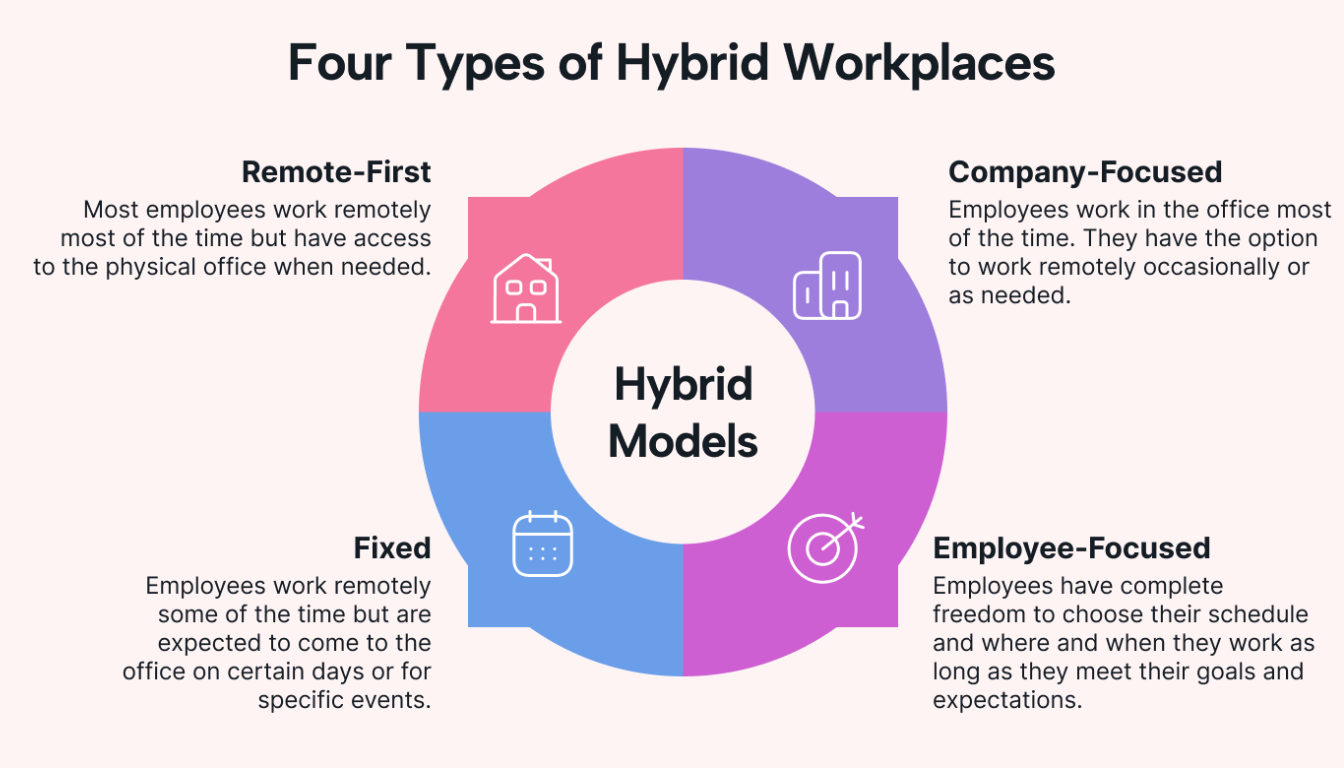The Future of Hybrid Workplace: Trends and Strategies for 2025

Curious about the future of the hybrid workplace? By 2025, hybrid work is shaping how organizations function. Dive into the key trends, strategies, and what lies ahead in the future of the hybrid workplace, helping you navigate the evolving work landscape.
Key Takeaways
- Hybrid workplaces have evolved into a sustainable model that combines remote and in-office work, driven by employees' demand for flexibility and a better work-life balance.
- Key trends for 2025 include increased reliance on AI and technology integration to enhance productivity, alongside a focus on employee well-being and mental health in hybrid environments.
- Successful hybrid work strategies require effective policy design, investment in collaboration tools, and intentional efforts to maintain workplace culture and team cohesion.
The Evolution of Hybrid Workplaces

The COVID-19 pandemic was a catalyst that accelerated the global adoption of hybrid work, pushing organizations to pivot to remote and hybrid work and flexible work arrangements almost overnight. This shift led to a significant transformation in the workplace, with more than half of remote-capable workers in the U.S. operating in a hybrid capacity by early 2023. Hybrid work is no longer a temporary solution; it has become a sustainable long-term strategy that companies across various industries are embracing.
Today’s hybrid workplace model is a blend of remote and in-office work, with organizations implementing varied work schedules to enhance employee satisfaction and productivity. Modern workplaces now feature open floor plans and collaborative zones designed to facilitate both remote and in-office work, regardless of the physical location.
As we move further into 2025, hybrid models have become the norm, fundamentally changing how companies operate and interact with their employees over the past year. This evolution requires continuous evaluation and optimization of strategies to ensure future success with a hybrid model.
Key Trends Shaping Hybrid Workplaces in 2025

The landscape of hybrid workplaces is being shaped by several key trends in 2025. Flexibility, improved work-life balance, and increased productivity are at the forefront of these trends. Employees are demanding more flexible arrangements. They want a mix of in-office and remote work options, which is indicative of the future of work. As employees work, they strive to find a balance that enhances their overall job satisfaction.
In response, large companies are adapting to these changes by embracing them to meet the evolving preferences and needs of their employees.
Increased Flexibility and Work-Life Balance
Flexibility has become a top priority for employees, many of whom now value a better work-life balance even more than salary. This shift has led employers to recognize that hybrid work can reduce employee burnout and increase autonomy. With 83% of employees valuing work-life balance, companies are experimenting with flexible work arrangements, such as four-day workweeks and flexible hours, to support their workforce, including options for working two or three days a week. These flexible policies not only cater to employee preferences but also enhance productivity by allowing employees to choose work environments that match their tasks.
In today’s hybrid workplace, many employees are blocking off focus time to improve productivity, indicating that flexible work arrangements play a crucial role in achieving a better work-life balance. Moreover, the ability to manage personal time effectively, with 20% of workers ignoring company communications outside of work hours, shows the positive impact of flexible work on individual time management.
AI and Technology Integration
Technology is revolutionizing hybrid workplaces, with artificial intelligence (AI) playing a pivotal role in transforming daily operations and enhancing productivity. By 2025, AI will play a key role in hybrid work environments, making employee training essential to harness its benefits. AI and automation simplify workflows, improve efficiency, and even enhance safety by analyzing data to promote social distancing in physical office spaces.
The surge in demand for remote collaboration tools showcases the importance of technology in hybrid work models. Employers are focusing on:
- Mobile-enabled and device-agnostic productivity tools to meet the needs of hybrid employees
- Cloud-based services
- Robust security infrastructures
- Advanced collaboration tools
These elements are crucial for enhancing productivity and communication in hybrid workplaces.
Employee Well-Being and Mental Health
Employee well-being and mental health have become critical areas of focus in hybrid workplaces. Key points include:
- Employers recognize that hybrid work can enhance employee well-being and reduce turnover rates.
- The hybrid work model allows organizations to access a broader range of candidates, showcasing its impact on talent acquisition.
- Despite these benefits, 89% of workers report no improvement in work-related anxiety, indicating a need for better mental health support.
Women and Millennials report the highest stress spikes in the workplace, highlighting the need for targeted mental health support. Organizations need strategies to boost employee engagement, enhance well-being, and lower turnover intentions to address these issues. This includes creating supportive environments and providing resources to help most employees effectively manage work-related stress and anxiety.
Strategies for Successful Hybrid Work Models

Implementing successful hybrid work models requires strategic solutions and modern human resources technologies. Leaders must strike a balance between individual flexibility and team effectiveness to create a harmonious hybrid work environment that supports a hybrid workforce, including both hybrid workers and traditional office-based workers.
Identifying tasks that are suited for remote work versus those that require in-person collaboration is crucial for achieving this balance.
Policy Design and Implementation
Effective hybrid policies should reflect a balance between employee preferences and organizational needs. Empowering teams to design their hybrid practices can lead to improved hybrid workplace practices. Clear communication is essential for a successful hybrid policy.
Businesses are reevaluating their real estate needs, often opting for smaller or redesigned office spaces to accommodate flexible work arrangements. Conducting team reset meetings to align on goals and commitments is a recommended starting process in a hybrid environment, especially as companies prepare for a return to the office.
Investing in Collaboration Tools
Cloud-based tools are crucial for facilitating communication in hybrid work settings. Practical communication tools, including video conferencing, bridge the gap between remote and in-office employees, ensuring that all team members stay connected and productive. Organizations that invest in innovative tools for recruitment, onboarding, and productivity can enhance the hybrid work experience.
Effective communication and planning strategies are essential for fostering a connected workplace in hybrid teams, characterized by transparent and open communication.
Building a Strong Workplace Culture
Maintaining a cohesive culture in hybrid settings requires intentional efforts in team bonding and communication. Developing virtual social opportunities can help many organizations and prevent employee isolation in hybrid workplaces.
Offsite facilitates corporate retreats designed to create meaningful connections among hybrid teams, enhancing collaboration and team morale. These retreats provide tailored services that help companies make impactful in-person gatherings, improving team dynamics and collaboration.
Overcoming Challenges in Hybrid Work Environments

While hybrid work offers many benefits, it also presents unique challenges. Companies face issues related to collaboration, communication, and cultural alignment. Flexibility and autonomy in hybrid work can lead to increased coordination and collaboration challenges, particularly in hybrid arrangements.
Overcoming these challenges is crucial for the success and effectiveness of hybrid workplaces.
Ensuring Equitable Opportunities
Ensuring equitable opportunities in hybrid work environments is crucial for meeting the diverse needs of employees. Managers recognize the need for flexibility to cater to these requirements. Trust is a cornerstone of equitable workplaces, and covert monitoring of employees tends to erode this trust.
Addressing concerns about work-life balance and long commutes is also crucial for maintaining employee well-being.
Managing Team Cohesion
Customizing guidelines based on team needs can foster an inclusive and cohesive culture in hybrid teams. Collaborating on strategy and holding each other accountable are key practices for the effective execution of hybrid work strategies.
Team cohesion is essential for fostering a collaborative atmosphere and enhancing productivity in hybrid work environments.
Security and Data Management
In hybrid work models, organizations face increased security risks that must be actively managed to protect sensitive information. HR and IT departments must prioritize end-user education and security to manage these risks effectively. Educating end-users about security practices is essential for mitigating risks and ensuring the safety of organizational data.
AI technologies can also streamline workflows and enhance overall efficiency in hybrid work settings, thereby contributing to improved security.
The Role of Leadership in Hybrid Workplaces
Leadership plays a crucial role in the success of hybrid workplaces by cultivating a strong hybrid culture. Strong manager-employee relationships are essential to fostering this culture, driving both employee retention and engagement throughout the organization. With 92% of employees valuing supportive management, leaders must foster positive relationships and create a supportive environment. The CAARE framework helps leaders manage hybrid teams by emphasizing:
- Configuration
- Autonomy-alignment
- Relationships
- Equity
Designing a strong hybrid workplace requires implementing hybrid policies, offering flexible schedules, and creating office spaces that foster collaboration and a positive culture. Effective strategies include clear communication, simplified technology, and a focus on outcomes.
When bringing employees to the office, leaders should focus on collaboration, professional development, customer relations, and relationship building.
How Offsite Supports Hybrid Work
Offsite supports the shift to hybrid work by helping organizations plan intentional gatherings that foster collaboration, culture, and strategy alignment. Through curated off-site experiences, companies can make the most of in-person time in a predominantly hybrid world.
Simplifying Corporate Retreat Planning
Offsite simplifies corporate retreat planning by offering curated venues, vendors, and comprehensive planning services. Users can select preferred venues and vendors, then send booking requests within minutes, receiving detailed proposals within 48 hours.
Offsite provides end-to-end retreat planning services at a flat, per-person rate, ensuring a seamless booking experience. This focus on making off-site planning effortless allows users to concentrate on their team.
Cost Savings and Efficiency
Users can save up to 50% on retail rates with Offsite’s services. Offsite partners with premier offsite venues globally, which offer discounts because of the business Offsite brings to them.
The efficiency of Offsite’s planning process allows organizations to focus on their retreat objectives without getting bogged down in logistics. Overall, using Offsite enhances cost savings and operational efficiency for businesses planning corporate retreats.
Enhancing Team Collaboration
Offsite’s services are designed to foster collaboration during in-person gatherings through curated experiences that promote interaction and teamwork. These experiences enhance team dynamics and collaboration, making the most of in-person time in a hybrid work model.
By facilitating meaningful connections among team members, Offsite helps organizations achieve better collaboration and a more balanced work-life approach.
Summary
Summarize the key points discussed in the blog post, highlighting the evolution of trends in, strategies for, and challenges to hybrid workplaces, as well as the leadership roles involved. Conclude with an inspiring message about the future of hybrid work and its potential to transform the modern workplace.
FAQs
- What service does Offsite provide for corporate retreat planning?
Offsite offers a streamlined solution for corporate retreat planning, providing curated venues, vendors, and comprehensive planning services to ensure a seamless experience for organizations.
- How much can users save on venue bookings through Offsite?
Users can save up to 50% on venue bookings with Offsite, significantly reducing their costs compared to retail rates.
- What is the process for submitting booking requests through Offsite?
To submit booking requests through Offsite, simply choose your desired venues and vendors, then send your requests. You can expect to receive detailed proposals within 48 hours.
- What kind of support does Offsite offer for corporate retreat planning?
Offsite offers comprehensive retreat planning services at a flat, per-person rate, facilitating a seamless booking experience for corporate retreats. This approach ensures all aspects of planning are handled efficiently.
You may also like
Unique spaces for your next offsite
Find distinctive venues for your upcoming corporate retreat.
Stay Updated with Our Insights
Get exclusive content and valuable updates directly to you.







